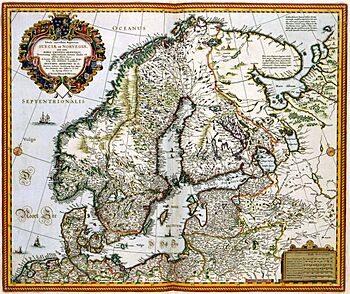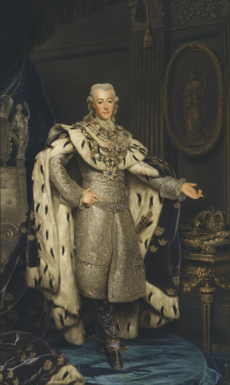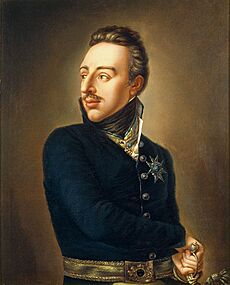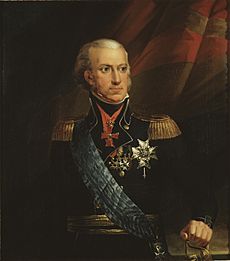Gustavian era facts for kids
Quick facts for kids
Kingdom of Sweden
Konungariket Sverige (Swedish)
|
|||||||||
|---|---|---|---|---|---|---|---|---|---|
| 1772–1809 | |||||||||
|
Anthem: Gustafs skål (1772–1792)
Gustav's Toast Bevare Gud vår kung (1805–1809) God Save Our King |
|||||||||
 |
|||||||||
| Capital | Stockholm | ||||||||
| Common languages | Swedish (official) | ||||||||
| Religion | Church of Sweden (official) | ||||||||
| Government | Unitary absolute monarchy | ||||||||
| King | |||||||||
|
• 1772–1792 (first)
|
Gustav III | ||||||||
|
• 1792–1809 (last)
|
Gustav IV Adolph | ||||||||
| Regent | |||||||||
|
• 1792–1796 (first)
|
Charles, Duke of Södermanland | ||||||||
| Legislature | Riksdag of the Estates | ||||||||
| History | |||||||||
|
• Revolution of 1772
|
19 August 1772 | ||||||||
| 16 March 1792 | |||||||||
|
• Death of Gustav III and Succession of Gustav IV Adolph
|
29 March 1792 | ||||||||
|
• King Gustav IV Adolph deposed
|
29 March 1809 | ||||||||
|
• Constitutional monarchy restored
|
6 June 1809 | ||||||||
| Currency | Riksdaler | ||||||||
| ISO 3166 code | SE | ||||||||
|
|||||||||
The period of Swedish history from 1772 to 1809 is often called the Gustavian era. It was named after Kings Gustav III and Gustav IV. This time also included the rule of King Charles XIII of Sweden. It was a time of big changes in how Sweden was governed and its place in Europe.
Contents
King Gustav III's Rule
King Adolf Frederick of Sweden passed away in February 1771. After his death, new elections were held. A political group called the Caps party gained some power. However, the nobility (rich and powerful families) were strongly against them. Nothing much could happen until the new king, Gustav III, returned from Paris.
Becoming King
When Gustav III was crowned, he had to agree to new rules. These rules were quite different from before:
- First, they tried to make sure a king could not give up his throne easily.
- Second, the king had to follow the decisions of the majority of the "estates." The estates were different groups of people who represented the country, like nobles, clergy, townspeople, and farmers. This rule helped the Caps party, who had many supporters in the lower estates.
- Third, when choosing people for important jobs, the king had to pick them only based on their skills, not on who they knew.
These new rules caused a lot of arguments throughout 1771. The king tried to help find a solution, but the townspeople's representatives were suspicious. In February 1772, the nobility finally agreed to the new rules.
New Government Rules
The Caps party, who were not nobles, then tried to change the Privy Council. This was a group of royal advisors. In April 1772, they managed to remove the old advisors. This made King Gustav III think about making a big change to the government.
On August 20, 1772, King Gustav III introduced a new set of rules for the country. This new constitution changed Sweden from a weak country ruled by many groups into a strong monarchy. Here's what it meant:
- The Riksdag (Sweden's parliament) could only meet when the king called them.
- The king could send them home whenever he wanted.
- The Riksdag could only discuss what the king put in front of them.
However, the king's power also had limits:
- He could not create new laws or get rid of old ones without the Riksdag's approval.
- He could not start an offensive war or collect special war taxes without their consent.
- Only the Riksdag could decide on taxes.
- They had full control over the Bank of Sweden and could check how the country's money was spent.
Most people in Sweden liked these changes. But in 1778, the Riksdag realized they had lost much of their power. The king was now truly in charge. He was polite, but he made it clear he intended to keep his power.
Things got difficult again eight years later. The Riksdag of 1786 was rebellious. They rejected almost all of the king's ideas. The king ended up taking back his proposals and sent the Riksdag home. He did not plan to call them back soon.
However, just three years later, the king had to call another Riksdag meeting in Stockholm in January 1789. His attempt to rule without parliament had not gone well. He had started a war against Russia in 1788, which was against his own constitution. A plot called the Anjala conspiracy stopped military actions. Then, the Danes invaded Sweden's western areas.
But during this difficult time, the king's dedication to his country stood out. Many nobles, who favored Russia, seemed disloyal. So, when the Riksdag met, the three lower estates strongly supported the king. With their help, Gustav managed to overcome the nobility's opposition. He made another big change on February 16, 1789. This was called the Act of Union and Security. It gave the king complete control over foreign affairs and the army. This made it much harder for anyone to betray the country. The nobility never forgave him for this.
Sweden's Role in Europe
Other countries were very interested in Sweden's changes. The Russian Empress, Catherine II of Russia, made a secret agreement with Denmark. They saw Sweden's changes as "an act of violence." They planned to step in and restore the old Swedish government if they got the chance.
Meanwhile, King Gustav had secretly renewed Sweden's alliance with France. The French King Louis XV promised to help Gustav if he brought back strong royal rule in Sweden. France also agreed to pay Sweden money it owed. A French diplomat, Charles Gravier, comte de Vergennes, was sent to Sweden to counter Russia's plans.
King Gustav IV's Rule
The next king, Gustav IV, was still a child when he became king. During his childhood, a man named Gustaf Reuterholm was largely in charge of Sweden.
Changes in Government
After the French king was executed in 1793, Sweden recognized the new French republic. Secret talks began for an alliance. But Russia and other European countries protested, so Sweden stopped these talks.
The talks with France made Gustav's supporters dislike the advisors of Charles, the duke-regent. These advisors were seen as too friendly with the French. A plot was formed to overthrow the government, led by Gustaf Mauritz Armfelt. This plot was supposed to be helped by Russia and a rebellion in a region called Dalecarlia. However, the plot was discovered and stopped.
New Alliances
During the wars happening in Europe, Sweden and Denmark became closer. In March 1794, they agreed to remain neutral. Their ships patrolled the North Sea to protect their trading vessels from British ships. Sweden officially recognized the French republic in April 1795. In return, Sweden received money and signed a treaty with France in September 1795.
Reuterholm tried to make Sweden friends with Russia again. Russia had stopped talking to Sweden. But King Gustav IV refused to marry the Russian Grand Duchess Alexandra, whom Reuterholm had chosen for him. This was Reuterholm's last official act. In November 1796, Gustav IV, at 18 years old, took full control of the government.
Gustav IV's Policies
King Gustav IV of Sweden ruled almost like an absolute monarch. At his very first Riksdag in March 1800, the nobility had to agree to Gustav III's Act of Union and Security.
Sweden's foreign policy changed in December 1800. Denmark, Sweden, and Russia joined a group called the second League of Armed Neutrality. This group was against Great Britain. Until then, Sweden had stayed out of European conflicts. But in 1804, Gustav IV developed a strong dislike for Napoleon. So, when other countries formed a group against Napoleon, Gustav was one of the first to join (December 3, 1804). He promised to send an army to help the English and Russians fight Napoleon in the Netherlands and Hanover.
However, his arguments with the King of Prussia kept him in Swedish Pomerania. By the time he led his 6,000 soldiers towards the Elbe in December 1805, the group against Napoleon had already broken apart after Napoleon's victories at Ulm and Austerlitz.
In 1806, a conflict between Sweden and Prussia was avoided only because Napoleon attacked Prussia. After his victory at Jena, Napoleon tried to get Sweden on his side, but Gustav refused. This led to Sweden losing Swedish Pomerania. The Swedish army was saved from being completely destroyed by the cleverness of Johan Christopher Toll.
At a meeting called Tilsit, the Russian Emperor Alexander I of Russia agreed to force Sweden to join a new "Continental Russian System" against England. Gustav IV refused all of Alexander's ideas to close the Baltic Sea to the English. But he also did not prepare to defend Finland against Russia. On February 21, 1808, a Russian army crossed the Finnish border. On April 2, the king ordered 30,000 men to be ready for war.
King Charles XIII's Rule
The Russian invasion quickly led to big changes in Sweden. On March 13, 1809, King Gustav IV Adolf was removed from power in a Coup of 1809. His entire family was also prevented from becoming king or queen.
On June 5, 1809, the duke-regent was made king. He took the name Charles XIII. He agreed to a new, more liberal constitution, which the Riksdag of the Estates approved the same day. Peace talks had begun, but the war continued. After defeats at the Battle of Sävar and Battle of Ratan in August 1809, the Swedish army lost hope. Peace was finally made by giving up all of Finland, the Åland islands, and parts of Västerbotten and Lappland up to the Torneå and Muonio rivers. This was agreed in the Treaty of Fredrikshamn on September 17, 1809.







